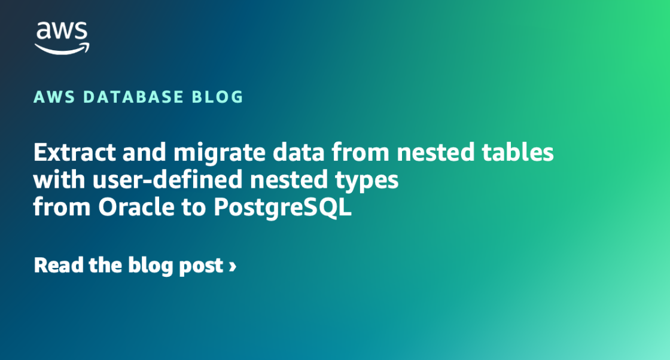Amazon
1M
164

Image Credit: Amazon
Extract and migrate data from nested tables with user-defined nested types from Oracle to PostgreSQL
- Migrating data from Oracle to PostgreSQL involves understanding the differences in handling nested tables and user-defined types (UDTs) between the two systems, requiring additional steps for completion.
- Oracle's nested table feature supports multi-valued attributes through sub-tables, while PostgreSQL handles UDTs differently, necessitating careful consideration during migration.
- In Oracle, UDTs can have member functions integrated directly into them, unlike in PostgreSQL where member functions within UDTs are not currently supported, leading to the need for separate handling during migration.
- The migration process includes exploring different ways to implement UDTs in Oracle and ensuring the conversion of complex member type functions in multi-nested UDTs from Oracle to PostgreSQL.
- Prerequisites for migration include instances with Oracle databases, a properly sized AWS DMS replication instance, source and target endpoints connectivity, and a target Amazon RDS for PostgreSQL-compatible instance.
- The migration process involves extracting and transforming data from nested tables, understanding hierarchical structures, navigating multiple layers of data, and carefully converting complex member type functions.
- Two scenarios are discussed—one involving single-layer nested UDTs in the entertainment industry and the other dealing with multiple layers of nested UDTs in movie artists data management.
- Use of AWS Schema Conversion Tool (AWS SCT) for schema conversion, custom procedures for data extraction and transformation, and AWS DMS for data migration plays a crucial role in the migration process.
- After extracting data using AWS DMS, custom procedures are employed to load the transformed data into PostgreSQL tables, ensuring the integrity of complex nested data structures.
- Conclusion emphasizes strategies for extracting and migrating complex multi-nested UDTs from Oracle to PostgreSQL, with a focus on managing hierarchical data structures and executing flawless migrations.
Read Full Article
9 Likes
For uninterrupted reading, download the app